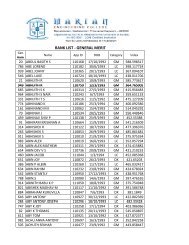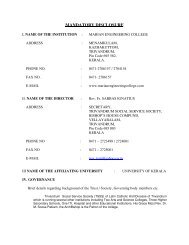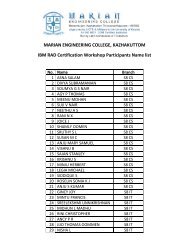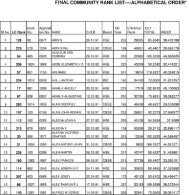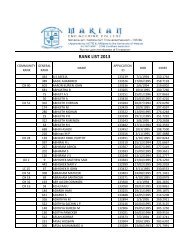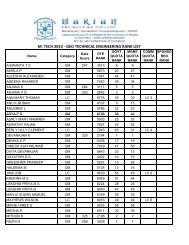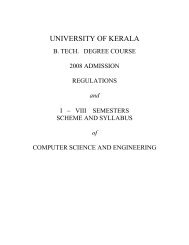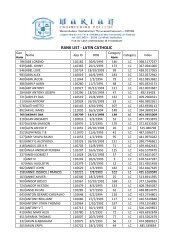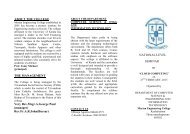UNIVERSITY OF KERALA - College of Engineering, Trivandrum
UNIVERSITY OF KERALA - College of Engineering, Trivandrum
UNIVERSITY OF KERALA - College of Engineering, Trivandrum
Create successful ePaper yourself
Turn your PDF publications into a flip-book with our unique Google optimized e-Paper software.
08.102 ENGINEERING PHYSICS<br />
L-T-P: 2-1- 0 Credits: 6<br />
MODULE-I<br />
Oscillations and Waves<br />
Basic ideas <strong>of</strong> harmonic oscillations – Differential equation <strong>of</strong> a SHM and its solution. Theory <strong>of</strong> damped<br />
harmonic oscillations. Quality factor. Theory <strong>of</strong> forced harmonic oscillations and resonance. Types <strong>of</strong> waves.<br />
One dimensional waves – Differential Equation. Harmonic waves. Three dimensional waves - Differential<br />
Equation and solution. Plane waves and spherical waves. Energy in wave motion. Velocity <strong>of</strong> transverse waves<br />
along a stretched string.<br />
Electromagnetic Theory<br />
Del operator – grad, div, curl and their physical significance. Concept <strong>of</strong> displacement current. Deduction <strong>of</strong><br />
Maxwell’s equations. Prediction <strong>of</strong> electromagnetic waves. Transverse nature <strong>of</strong> electromagnetic waves. E and<br />
H are at right angles. Poynting’s theorem (qualitative only)<br />
Physics <strong>of</strong> Solids<br />
Space lattice. Unit cell and lattice parameters. Crystal systems. Co-ordination number and packing factor with<br />
reference to simple cubic, body centered cubic and face centered cubic crystals. Directions and planes. Miller<br />
indices. Interplanar spacing in terms <strong>of</strong> Miller indices. Super conductivity - Meissner effect. Type-I and Type-II<br />
superconductors. BCS theory (qualitative). High temperature superconductors. Applications <strong>of</strong> superconductors.<br />
Introduction to new materials (qualitative) -Metallic glasses, Nano materials, Shape memory alloys, Bio<br />
materials.<br />
MODULE- II<br />
Interference <strong>of</strong> Light<br />
Concept <strong>of</strong> temporal and spatial coherence. Interference in thin films and wedge shaped films. Newton’s rings.<br />
Michelson’s interferometer. Determination <strong>of</strong> wave length and thickness. Interference filters. Antireflection<br />
coating.<br />
Diffraction <strong>of</strong> Light<br />
Fresnel and Fraunh<strong>of</strong>er diffraction. Fraunh<strong>of</strong>er diffraction at a single slit. Fraunh<strong>of</strong>er diffraction at a circular<br />
aperture (qualitative). Rayleigh’s criterion for resolution. Resolving power <strong>of</strong> telescope and microscope. Plane<br />
transmission grating. Resolving power <strong>of</strong> grating. Grating equation. X-ray diffraction. Bragg’s law.<br />
Polarization <strong>of</strong> Light<br />
Types <strong>of</strong> polarized light. Double refraction. Nicol Prism. Retardation plates. Theory <strong>of</strong> plane, circular and<br />
elliptically polarized light. Production and analysis <strong>of</strong> circularly and elliptically polarized light. Polaroids.<br />
Induced birefringence. Photo elasticity – isoclinic and isochromatic fringes – photo elastic bench<br />
Special Theory <strong>of</strong> Relativity<br />
Michelson-Morley experiment. Einstein’s postulates. Lorentz transformation equations (no derivation).<br />
Simultaneity. Length contraction. Time dilation. Velocity addition. Relativistic mass. Mass energy relation.<br />
Mass less particle.<br />
MODULE – III<br />
Quantum Mechanics<br />
Dual nature <strong>of</strong> matter. Wave function. Uncertainty principle. Energy and momentum operators. Eigen values<br />
and functions. Expectation values. Time Dependent and Time Independent Schrodinger equations. Particle in<br />
one dimensional box. Tunnelling (qualitative).<br />
Statistical Mechanics<br />
Macrostates and Microstates. Phase space. Basic postulates <strong>of</strong> Maxwell-Boltzmann, Bose-Einstein and Fermi-<br />
Dirac statistics. Distribution equations in the three cases (no derivation). Bosons and Fermions. Density <strong>of</strong><br />
states. Derivation <strong>of</strong> Planck’s formula. Free electrons in a metal as a Fermi gas. Fermi energy.<br />
Laser<br />
Einstein’s coefficients. Population inversion and stimulated emission. Optical resonant cavity. Ruby Laser,<br />
Helium-Neon Laser, Carbon dioxide Laser (qualitative). Semiconductor Laser (qualitative). Holography. Fiber<br />
Optics - Numerical Aperture and acceptance angle. Types <strong>of</strong> optical fibers. Applications.<br />
REFERENCE:<br />
1. Sears & Zemansky ; University Physics. XI Edn.,; Pearson<br />
2. Frank & Leno; Introduction to Optics. III Edn., , Pearson<br />
13



